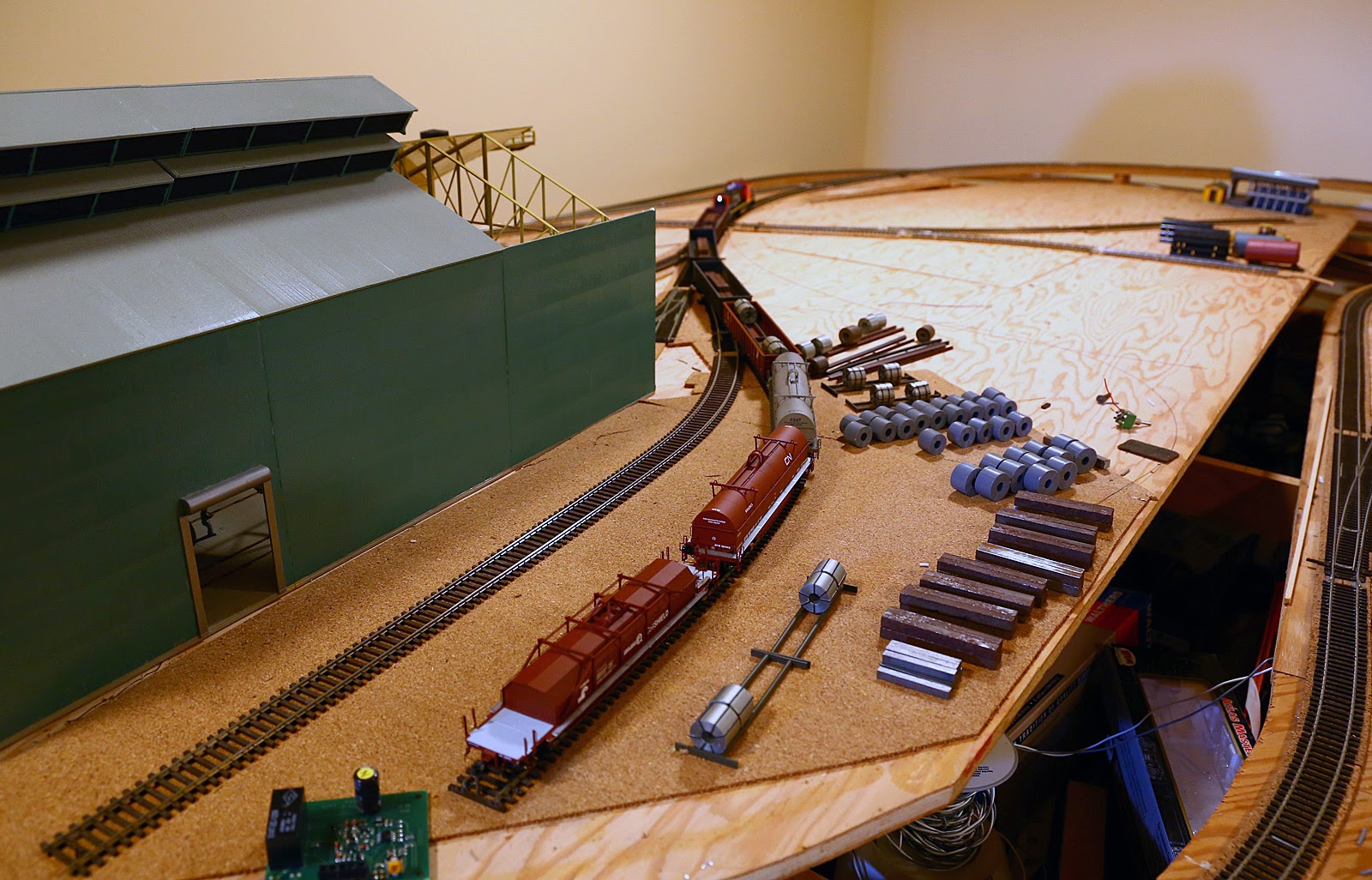 |
| CN 1906 pulls the first loads out of the recently-installed storage tracks in front of the Stelco (Walthers) rolling mill. Looks like they will soon have plenty more loads to pull! |
A few days spent working on the layout over the Christmas break yielded
some significant progress on the layout, namely completing the trackage on the
spur on the left (east) side of the layout. More industries to go and switch
now!
Carpentry
The basic benchwork was already in place, including a sheet of plywood cut
to fit in the available space; all that remained was to secure the sub-roadbed
in place. It was decided to use the two “high-line” switches already in place
to access the spur rather than run a new branch off of the existing yard lead. This
meant that the spur would be at a higher elevation than previously planned –
this allows a more eye-level view of activity on the spur, rather than a more
eye-in-the-sky view. This also helps to blend the high line into the rest of
the layout, rather than it creating a “stair case” illusion and seem to
arbitrarily rise out of the rest of the layout. A total of seven supports were
cut from spare 1x3” stock to elevate the plywood about four inches. Since the
two high line switches were at slightly different elevations due to the grade
that they are on, the elevation of the plywood sheet was set to split the
difference between the two. Three supports were fastened to the benchwork lengthwise
along the plywood and four were installed transversely – this stabilized the
plywood and makes it resistant to any bumps or jolts on the rest of the layout’s
benchwork. As this particular piece of plywood had been stored for a number of
years, one end of the sheet (south end) had developed a significant warp (curl)
that required a 2x4” attached transversely to the bottom to help straighten it
out (2x4 was planed to be perfectly straight). The last step in preparing the
plywood was to cut a hatch approximately 16” square into the middle; this not
only allows access in the event of a derailment or electrical glitch, but will
help with scenic-ing the layout as well. The seven risers (supports) were first
screwed to the bottom of the plywood at pre-marked and measured locations. Once
all were in place, the plywood was positioned at the appropriate height and the
risers clamped in place while pilot holes were drilled and screws put in place.
The sub-roadbed between the two switches on the high line consists of a segment
of plywood approximately six inches wide; a tapered “bridge” piece was placed
between this existing sub-roadbed and the newly installed plywood.
Surprisingly, very little adjustment was needed to align the three pieces of
plywood, and only some slight planing and sanding was required to smooth the
transition from the high line grade to the level plywood surface.
Once the plywood was installed, it was full speed ahead with the
trackwork for the new spur (actually two spurs that cross at a diamond, but
referred to as the spur for clarity). The facing high line switches each feed
one of two tracks that meet at a 90° crossing. The track on the spur is mostly code
83, a mix of Atlas, Shiniohara, and Peco. The north end of the
spur consists of a Walthers rolling mill (to be featured in a later post) that
was cut back to three segments (from original four) and another track next to the rolling mill that will
serve as a bulk fuel dealer. Two tracks will go into the mill building itself, and another two storage tracks were laid next to the building to hold the loads for pickup. The rails have not yet been installed in the building, as the channels in the floor are intended for a cars' wheel flanges, not actual rails. Hence the gap is too narrow to lay rail (gauge is too tight), but that will soon be corrected. These tracks cross over the
access hatch on three sides – each crossing was secured with extra spikes to ensure
the alignment remains intact.
To power the new spur, a new track bus was run under the
previously-unpowered high line and feeders installed between the rails and the
bus wires. Since the high line circles around and forms a reversing loop with what
is essentially the tail of the south yard lead (better-sounding name TBD), a
Digitrax auto-reverser was purchased. Mark made quick work wiring up, so now we
can run trains in a continuous loop up and around the high line.
 |
| After lifting cars from Stelco, two empty cars are lifted from the bulk fuel dealer. Extra track is stored temporarily at left. Note the high-tech temporary end of track device! |
Operations
Prior to completing the spur, there were only two industries already in
place on the layout, the grain elevator and the spur near the bridge (at least
for now, “Casco”). The addition of four new industries to switch will now
provide at least enough work for two jobs: a yard job to handle the sorting of
the cars and blocking of mainline freights, as well as switch the grain
elevator and Casco, and a second job to go and switch the spur. With increased
traffic on the layout, this will soon provide the opportunity to implement and
learn about track clearances, car card systems, and how to develop a natural “flow”
to operations between multiple operators. Can’t wait!
 |
| Lifting cars from the Stelco storage tracks at right; soon more empties will be spotted inside the building. |
Stay tuned for part II of the layout update sometime later in the week…
Thanks for looking,
Cheers,
Peter.


No comments:
Post a Comment